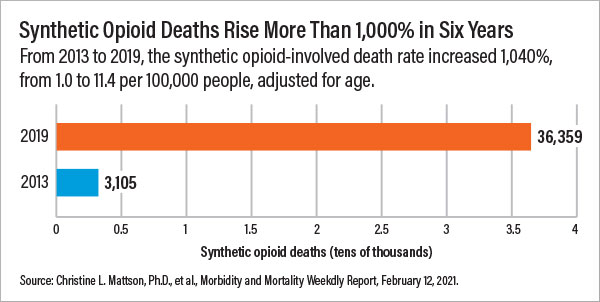The death rate from overdoses that involved synthetic opioids other than methadone, such as illicitly manufactured fentanyl, soared 1,040% in the United States from 2013 to 2019, a study in Morbidity and Mortality Weekly Report has found. The study also revealed recent geographic shifts in overdose deaths, with the greatest increase in deaths involving synthetic opioids occurring in the West and the greatest increase in deaths involving psychostimulants such as methamphetamine occurring in the Northeast.
“The worsening and expanding drug overdose epidemic in the United States is now largely driven by the use of potent synthetic drugs, often in combination with other substances, and requires urgent action,” lead author Christine L. Mattson, Ph.D., told Psychiatric News. Mattson is a senior health scientist in the Division of Overdose Prevention at the Centers for Disease Control and Prevention’s National Center for Injury Prevention and Control.
Mattson and colleagues analyzed drug overdose deaths that were identified in the National Vital Statistics System multiple cause-of-death mortality files. There were 70,630 drug overdose deaths in 2019, of which 70.6% involved opioids, such as heroin and certain prescription drugs, and 51.5% involved synthetic opioids. Deaths involving synthetic opioids increased from 3,105 in 2013 to 36,359 in 2019. The percentage of drug overdose deaths that involved synthetic opioids was highest in the Northeast, at 71.0%, and lowest in the West, at 26.4%. However, from 2018 to 2019, drug overdose deaths involving synthetic opioids increased 67.9% in the West.
“Synthetic opioids, particularly illicitly manufactured fentanyl and fentanyl analogs, are increasingly available across the United States and found in the supplies of other drugs,” said Mattson. “The increase in synthetic-opioid-involved deaths in the West signals broadened geographic use of these substances, which is consistent with increases in the number of drug submissions to forensic laboratories in those regions during 2018 and 2019.”
Between 2013 and 2019, the number of deaths involving psychostimulants rose from 3,627 to 16,167, reflecting a 317% increase in the psychostimulant-involved death rate. In 2019, the percentage of deaths involving psychostimulants was highest in the West, at 43.5%, and lowest in the Northeast, at 7.9%. However, from 2018 to 2019, overdose deaths involving psychostimulants increased 43.8% in the Northeast, followed by an increase of 36.1% in the Midwest and 32.4% in the South.
“Psychostimulant-involved deaths are likely rising because of increases in potency, availability, and reduced cost of methamphetamine in recent years,” Mattson said. She added that, as with the increase in deaths involving synthetic opioids in the West, the increase in deaths involving psychostimulants in the Northeast reflects geographically broader use of the drugs.
“We suggest that evidence-based prevention and response strategies, including substance use disorder treatment and overdose prevention efforts focused on polysubstance use, must address the changing drug overdose epidemic,” Mattson said. “This should include a coordinated approach from clinicians, public health, public safety, community organizations, and the public to prevent and respond to drug overdose, especially as geographic trends and substances involved in drug overdose deaths change.”
She added that this approach should include strategies such as enhanced ways of linking patients to treatment for substance use disorder and helping them stay in treatment, improving prescription drug monitoring programs, implementing post-overdose protocols in emergency departments, and expanding naloxone education and distribution. This study was not supported by outside funding. ■
“Trends and Geographic Patterns in Drug and Synthetic Opioid Overdose Deaths—United States, 2013-2019” is posted
here.

